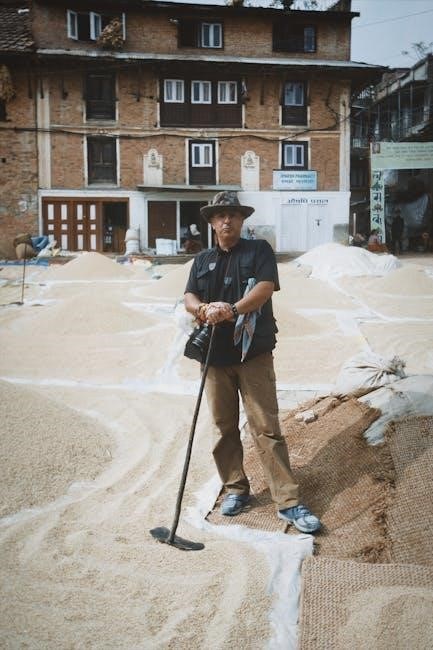Oster Rice Cooker Manual: A Comprehensive Guide
Welcome to your ultimate resource for mastering the Oster Rice Cooker! This comprehensive guide provides step-by-step instructions, safety precautions, and helpful tips to ensure perfect rice every time. Embrace effortless cooking and explore diverse culinary possibilities with your Oster Rice Cooker.
Understanding Your Oster Rice Cooker Model
Before diving into delicious rice dishes, it’s crucial to understand your specific Oster Rice Cooker model. Oster offers a variety of rice cookers, each with unique features and functionalities. Refer to your model’s manual, often available for download online, to identify its specific components, such as the inner pot, control panel, and steaming tray if included.
Knowing your model number, such as CKSTRC6S-DM or 4715, will help you access precise instructions and troubleshooting tips. Familiarize yourself with the user manual to ensure safe and efficient operation, and to unlock the full potential of your Oster rice cooker.

Key Features and Components
Oster Rice Cookers boast key components like the inner pot with non-stick coating, a control panel with various settings, and often include accessories such as a measuring cup and rice ladle for easy and efficient operation.
Inner Pot and Non-Stick Coating
The inner pot is a critical component of your Oster Rice Cooker, typically featuring a non-stick coating. This coating prevents rice from sticking to the bottom, making cleanup significantly easier. To maintain the integrity of the non-stick surface, avoid using metal utensils or abrasive cleaners. Opt instead for the provided rice ladle or other non-abrasive tools. Proper care will prolong the life of the inner pot and ensure consistent cooking results. Remember to always let the pot cool before cleaning to prevent damage. A damaged non-stick surface can affect cooking performance and make cleaning more difficult, so handle it with care.
Control Panel and Settings
Understanding the control panel of your Oster Rice Cooker is essential for optimal use. Typically, the panel includes a “Cook” setting for cooking rice and a “Warm” setting to keep rice at a serving temperature after cooking. Some models may offer additional settings for steaming or cooking different types of grains. The “Cook” setting usually activates automatically when the rice cooker is plugged in and the power switch is engaged. Once the rice is cooked, the cooker automatically switches to the “Warm” setting. Familiarize yourself with the specific settings on your model to achieve the desired cooking results for various recipes. Refer to your user manual for detailed explanations.

Initial Setup and Preparation
Before using your Oster Rice Cooker, thoroughly clean all components, including the inner pot and lid. Accurate rice and water measurements are crucial for achieving perfectly cooked rice. Let’s get started with the initial setup!
Cleaning Before First Use
Before you embark on your rice-cooking journey with your new Oster appliance, it’s essential to ensure all components are sparkling clean. This initial cleaning removes any manufacturing residues and ensures optimal performance. Start by detaching the inner pot, lid, rice paddle, measuring cup, and steaming tray (if included).
Wash these items thoroughly with warm, soapy water. Use a soft sponge or cloth to avoid scratching the non-stick coating of the inner pot. Rinse each component meticulously under running water to remove all traces of soap. Finally, dry all parts completely before assembling the rice cooker for its maiden voyage.
Proper Rice Measurement and Water Ratios
Achieving perfectly cooked rice hinges on accurate measurement of both rice and water. The Oster Rice Cooker typically includes a measuring cup specifically designed for this purpose. Remember that one cup of uncooked rice generally yields two cups of cooked rice.
For white rice, a common ratio is 1 cup of rice to 2 cups of water. However, water ratios may vary depending on the type of rice. For softer rice, add slightly more water; for firmer rice, use slightly less. Brown rice usually requires more water than white rice, often around 2.5 cups of water per cup of rice.
Cooking Rice: Step-by-Step Instructions
Mastering rice cooking is simple with these instructions. From adding ingredients to selecting the right mode, we’ll guide you through each step. Enjoy perfectly cooked rice every time with your Oster Rice Cooker!
Adding Rice and Water
Begin by measuring your desired amount of rice using the provided Oster measuring cup. One cup of uncooked rice typically yields approximately two cups of cooked rice. Rinse the rice thoroughly under cold water to remove excess starch, which helps prevent stickiness. Place the rinsed rice into the inner pot of your Oster rice cooker.
Next, add the appropriate amount of water. The general rule is to use a 1:2 rice-to-water ratio for white rice, but this may vary depending on the type of rice you are using. Brown rice often requires more water. Refer to the manual for precise measurements, and add water to the corresponding level marked on the inner pot. For softer rice, allow the rice and water to soak for 10-20 minutes.
Selecting the Correct Cooking Mode
Once the rice and water are in the inner pot, ensure the pot is properly seated within the rice cooker. Close the lid securely. Now, it’s time to select the appropriate cooking mode on the control panel. Most Oster rice cookers offer settings like “Cook” or “Rice,” which are ideal for standard white rice.
For brown rice, choose the “Brown Rice” setting, as it requires a longer cooking time. Some models may also feature options for steaming or quick rice. Select the mode that best suits your needs, ensuring optimal cooking results. The rice cooker will automatically switch to “Keep Warm” once the cooking cycle is complete, maintaining the rice at an ideal serving temperature.
Maintaining Your Oster Rice Cooker
Proper maintenance ensures your Oster rice cooker’s longevity and performance. Regular cleaning, following recommended procedures, and prompt troubleshooting of common issues are key to keeping your appliance in excellent working condition for years to come.
Cleaning Procedures
To maintain your Oster rice cooker, always unplug it and allow it to cool completely before cleaning. Wash the inner pot, lid, rice paddle, and steaming tray (if applicable) with warm, soapy water; Avoid using abrasive cleaners or metal utensils, as they can damage the non-stick coating of the inner pot. Rinse thoroughly and dry all parts before reassembling. Wipe the exterior of the rice cooker with a damp cloth. Ensure no water enters the cooker’s base. For stubborn food residue, soak the inner pot in warm, soapy water. Regular cleaning prevents buildup and ensures optimal performance and longevity of your appliance.
Troubleshooting Common Issues
If your Oster rice cooker isn’t working, first ensure it’s properly plugged in and the outlet is functional. If the rice is undercooked, use more water in future batches or allow it to soak before cooking. For overcooked rice, reduce the water amount next time. If the rice cooker shuts off too soon, check the water level and ensure the heating element is clean. If rice sticks to the bottom, avoid metal utensils and ensure even water distribution. For error codes, consult your specific model’s manual. If problems persist, contact Oster customer support or a qualified appliance repair technician.

Safety Precautions
Prioritize safety with your Oster Rice Cooker by reading all instructions before use. Always unplug the cooker when not in use and avoid immersing the base in water. Ensure proper ventilation and supervise children during operation.
Important Safety Guidelines
To ensure safe operation of your Oster Rice Cooker, always use it on a stable, heat-resistant surface. Never operate the appliance with a damaged cord or plug. Keep the rice cooker away from flammable materials and do not place it near a gas or electric stove. Avoid touching hot surfaces during or immediately after cooking; use the provided handles or oven mitts.
Unplug the rice cooker before cleaning and allow it to cool completely. Do not immerse the cooker base in water. Regularly inspect the power cord for any signs of damage and never attempt to repair the appliance yourself.
Avoiding Common Mistakes
One common mistake is using incorrect water ratios, leading to undercooked or mushy rice. Always adhere to the recommended water levels for your chosen rice type. Another frequent error is using metal utensils, which can scratch and damage the non-stick coating of the inner pot. Opt for plastic or wooden utensils instead.
Avoid overfilling the rice cooker, as this can cause spillage and affect cooking performance. Ensure the inner pot is properly seated within the cooker before starting. Neglecting to clean the rice cooker regularly can also lead to issues; always follow the recommended cleaning procedures.

Recipes and Usage Tips
Unlock the full potential of your Oster Rice Cooker! Explore diverse rice varieties and experiment with delicious recipes. Discover usage tips for steaming vegetables and other foods, expanding your culinary horizons with ease and convenience.
Exploring Different Rice Varieties
Your Oster Rice Cooker isn’t just for white rice! Dive into the world of grains and discover how to perfectly cook various rice types. From the delicate fragrance of Basmati to the nutty flavor of brown rice, each variety brings a unique texture and taste to your table. Refer to your Oster manual for recommended water ratios, typically around 1.5 cups of water for Basmati and 2 cups for brown rice per cup of rice.
Experiment with softer Oriental rice, adjusting the water ratio slightly for desired consistency. Enjoy the versatility of your rice cooker!
Steaming Vegetables and Other Foods
Unlock your Oster Rice Cooker’s full potential by using it to steam vegetables and other foods! Many Oster models come equipped with a steaming tray, making it easy to prepare healthy and delicious meals. Simply add water to the inner pot, place the steaming tray on top, and arrange your vegetables or other foods on the tray.
Refer to your Oster manual’s steaming time guide to determine the appropriate cooking time for different foods. You can steam anything from broccoli and carrots to dumplings and seafood, expanding your culinary horizons with ease.